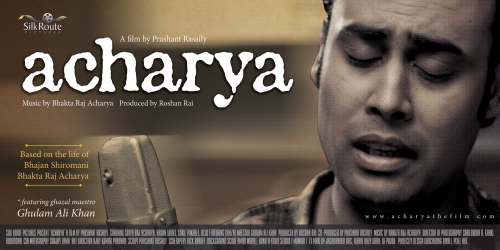You’ve got to give it to the director Prashant Rasaily for the movie ‘Acharya’. It really takes Nepali film industry to another level and leaves other directors to shame. If there is one movie that would make a difference this year, it would be Acharya. Forget Dasdhunga, talking purely on how the film’s been made (since both are based on real stories, although the later is partly fictionalized).
Two of my friends and I went to QFX Kumari to watch Acharya, yesterday morning. It was super lame that even though the movie was supposed to begin at 11:30 am, the doors only opened at the stated time. We had to sit around for the next half hour watching advertisements. I didn’t pay entertainment tax to watch a whole half an hour of advertisements (very few movie trailers). 5 mins late is acceptable, but this was way too much. It was bad QFX.
Acharya is a movie based on the life of Bhajan Shiromani Bhakta Raj Acharya. Jaha chan buddha ka ankha…is probably the one song that most of us know. I remember watching the video on nepal television as a kid.
What the three of us liked in the movie was the overall direction, the cast and their performance, the sound, the quality of the picture and of course, we love the songs. They were some poignant empty shots and the piano playing in the background really went well; director of photography did a good job.
Aruna Karki’s performance as Bhakta Raj Acharya’s wife was one of the best in the movie. While we did weigh out the fact that someone else could have played the main role besides Satya, Acharya’s son, we concluded that Satya is someone who best knows his father (and has seen what he has been through as a child) and therefore, can portray him the best possible way. His acting was commendable.
There’s a lot of vertical and horizontal panning of shots. Even in the beginning we follow Acharya down the spiral staircase; during the music competition the vertical panning takes us to the speakers on the top of the stage; at radio nepal, we see the sign and then the panning leads us to the first floor, etc. etc. etc. etc. Kahile kahi overdose lage pani, it was okay. They did focus a lot on things and objects while the singer’s voice plays in the backdrop. Nuzhat Qazi’s costume designing is also good. Technically, it is so so so much better than any Nepali movie i’ve watched this year, so I am not really complaining. C’mon I started the year with Ek din ek Raat, and the last movie I’d watched was Chodi Gaye Paap Lagla. There was nothing to take away from those two pictures.
Acharya tells a heart rendering story of one of the best singers of the country (who recorded over 400 songs), the reality of how artists struggle, and the tragedy that left the singer without his voice. That in itself makes the movie a must see. We don’t see why the government needs to promote the movie though. If you’ve made a good movie, that should and will bring audiences to the theater. Forget getting government support and their lobbying. Bhakta Raj Acharya is a national asset and while we are proud of him, to expect the government to promote this movie is unrealistic.
On the other hand, the movie still could have been better. So after the movie ended, we discussed about the aspects that we thought could have been better.
NOTE: THIS IS PURELY ANALYZING THE MOVIE, technically. We respect Bhajan Shiromani with all our hearts; in no way is this review an analysis of his life and achievements.
1. the director of photography and the editor is the same person..think so (hehehe). anyways, while there were some poignant empty shots of the tea gardens and boudha and temples and mountains…there were way tooo many of those. They lengthened the movie unnecessarily. how many times do we have to look at the tea gardens? editing is important and that person should have been someone else. u need a third person’s perspective on this or else you’ll feel like putting in everything that you’ve shot.
2. lack of a proper timeline…now when did Acharya come to Kathmandu, when did he join Radio Nepal, how old was he? There is no timeline. how old is he now? This is a major weakness of the story. It is a biography but we don’t even know how old he was when one event happened. There are no years mentioned in the plot. Just that his career at radio nepal lasted for 16 years, until he was diagnosed with cancer. Which year did this happen? No clue.
3. Places are not well established. similar to the timeline, we don’t know where Acharya stayed when he came t o Kathmandu. we see a lot of patan durbar square and boudha, but it’s never clear where he lived. they established Kathmandu as the place, but were never specific in which area of Kathmandu. the couple shifted from location to location, but we never know where they shifted to. For us, who live in kathmandu, this would have been a crucial piece of information, to really situate ourselves in the story. this would have been easy to do…just put in a subtitle mentioning the place and year.
4. Sunil pokhrel…kudos to the casting director for the rest of the actors, but sunil pokhrel was definitely not the right person for the reporter’s role, or he just didn’t act as well as we’d imagined. He was awkward. Also, I wanted to know if a reporter had really come to the hospital while Acharya had been admitted. Was that a fiction set up for the entire narrative to unroll or did that really happen? Anyone?
5. There’s no proper climax in the movie. This is my friend A’s analysis. Yes, there’s the part where he attempted to commit suicide, but we feel that it should have been when he found that he has cancerous cells in his tongue. this is what changed everything.
6. Some characters weren’t established well. Like who were the two men at Radio Nepal that Acharya first met? Who is that businessman that lends him money? Who is this Navaraj guy? Who else did he deal with? We only know bits and pieces. Only that guy whom he met on the bus to Sikkim, we get to know him quite a bit, but we also never know what he does. Yes, the movie is about Acharya, but these are people who played crucial parts in his life, but we never know them clearly.
7. Ghulam Ali’s appearance. Unfortunately, i didn’t think that needed to be the biggest highlight of the movie. with his name all over the hoarding boards. Also, the frame, ghulam ali’s head was cut off on top while he sang…it would come into the frame and go out of the frame, the top part of his head.
8. What should have been the highlight was Acharya receiving his recognition as bhajan shiromani and the gorkha dakshin bahus, or at least some reference to those should have been made. Ghulam Ali’s praise for him is on one side, but him receiving the highest national level of awards, to appear only as text in the prologue was not justifiable. some photo reference, or sth could have been made. Like mentioned before, we don’t really get to know when he received those awards as the movie flows..the lack of a timeline. mentioning at the beginning is not enough.
9. Who were his contemporaries in the music background? wasn’t he influenced by other nepali contemporary singers? what was the music industry like during those days? Once again, we never see what the then environment was like, besides the vehicles and the clothes…why was he of all the singers chosen as the bhajan shiromani. these questions are not touched upon. the answer might be that we can’t show everything in one movie. but, choosing what to show is key. the contextualization of his life to kathmandu’s burgeoning adhunik lok geet scene is very important. show us a few seconds, or a minute at least..it’s important for the audience to know what was happening in the entire industry as well. a lot of us, in this generation, don’t know how radio nepal functioned at that time. we are left to guessing and doing our background study after the movie is over. if you are someone who had never heard of Bhakta Raj Acharya, it’s difficult to situate his story and to fully understand his biography. there is a lot of information that remains untold. we also never learn what happen to his family back in india, too. the story is too streamlined in some parts.
11. the silliest part and yes, really really unnecessary part of the movie was the ending. not talking about the real acharya’s appearance. that was key for us. we need to see how he is now. talking about the part where his sons satya-sworup are introduced by this emcee as great singers of today…blah blah blah and they sing..THIS PART SHOULD HAVE BEEN IN TEXT, in the EPILOGUE of the film. really, it was just ‘blowing their own trumpets’ kind of scene.
12. lastly, satya is a little too plump in the movie to portray a struggling character who doesn’t have any thegan (idea) of when how he would put together his next meal. he should have lost some weight to play the role. dark circles and makeup are not enough.
BUT, DO GO TO SEE THE MOVIE. IT IS WORTH EVERY SINGLE RUPEE AND YOUR ENTERTAINMENT TAX. :-P I highly recommend it to anyone. and it’s great that it’s been selected for the Mumbai film festival. way to go team!





